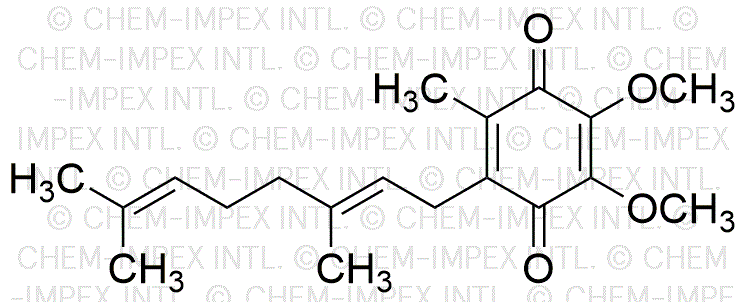Coenzyme Q2 is widely utilized in research focused on:
- Cellular Energy Production: It plays a crucial role in the electron transport chain, helping to generate ATP, which is essential for energy in living cells. This application is particularly relevant in studies of cellular metabolism and bioenergetics.
- Antioxidant Properties: Coenzyme Q2 acts as a potent antioxidant, protecting cells from oxidative stress. This is beneficial in research related to aging, neurodegenerative diseases, and cancer, where oxidative damage is a key concern.
- Cardiovascular Health: It is studied for its potential to improve heart function and reduce symptoms of heart disease. Researchers are exploring its use in supplements aimed at enhancing cardiovascular health.
- Skin Health: Coenzyme Q2 is incorporated into skincare products for its ability to promote skin rejuvenation and protect against UV damage. This application is gaining traction in the cosmetic industry.
- Neurological Research: Its role in mitochondrial function makes it a focus in studies aimed at understanding and treating neurological disorders, such as Parkinson's disease, where mitochondrial dysfunction is often observed.
General Information
Properties
Safety and Regulations
Applications
Coenzyme Q2 is widely utilized in research focused on:
- Cellular Energy Production: It plays a crucial role in the electron transport chain, helping to generate ATP, which is essential for energy in living cells. This application is particularly relevant in studies of cellular metabolism and bioenergetics.
- Antioxidant Properties: Coenzyme Q2 acts as a potent antioxidant, protecting cells from oxidative stress. This is beneficial in research related to aging, neurodegenerative diseases, and cancer, where oxidative damage is a key concern.
- Cardiovascular Health: It is studied for its potential to improve heart function and reduce symptoms of heart disease. Researchers are exploring its use in supplements aimed at enhancing cardiovascular health.
- Skin Health: Coenzyme Q2 is incorporated into skincare products for its ability to promote skin rejuvenation and protect against UV damage. This application is gaining traction in the cosmetic industry.
- Neurological Research: Its role in mitochondrial function makes it a focus in studies aimed at understanding and treating neurological disorders, such as Parkinson's disease, where mitochondrial dysfunction is often observed.
Documents
Safety Data Sheets (SDS)
The SDS provides comprehensive safety information on handling, storage, and disposal of the product.
Product Specification (PS)
The PS provides a comprehensive breakdown of the product’s properties, including chemical composition, physical state, purity, and storage requirements. It also details acceptable quality ranges and the product's intended applications.
Certificates of Analysis (COA)
Search for Certificates of Analysis (COA) by entering the products Lot Number. Lot and Batch Numbers can be found on a product’s label following the words ‘Lot’ or ‘Batch’.
*Catalog Number
*Lot Number
Certificates Of Origin (COO)
This COO confirms the country where the product was manufactured, and also details the materials and components used in it and whether it is derived from natural, synthetic, or other specific sources. This certificate may be required for customs, trade, and regulatory compliance.
*Catalog Number
*Lot Number
Safety Data Sheets (SDS)
The SDS provides comprehensive safety information on handling, storage, and disposal of the product.
DownloadProduct Specification (PS)
The PS provides a comprehensive breakdown of the product’s properties, including chemical composition, physical state, purity, and storage requirements. It also details acceptable quality ranges and the product's intended applications.
DownloadCertificates of Analysis (COA)
Search for Certificates of Analysis (COA) by entering the products Lot Number. Lot and Batch Numbers can be found on a product’s label following the words ‘Lot’ or ‘Batch’.
*Catalog Number
*Lot Number
Certificates Of Origin (COO)
This COO confirms the country where the product was manufactured, and also details the materials and components used in it and whether it is derived from natural, synthetic, or other specific sources. This certificate may be required for customs, trade, and regulatory compliance.

